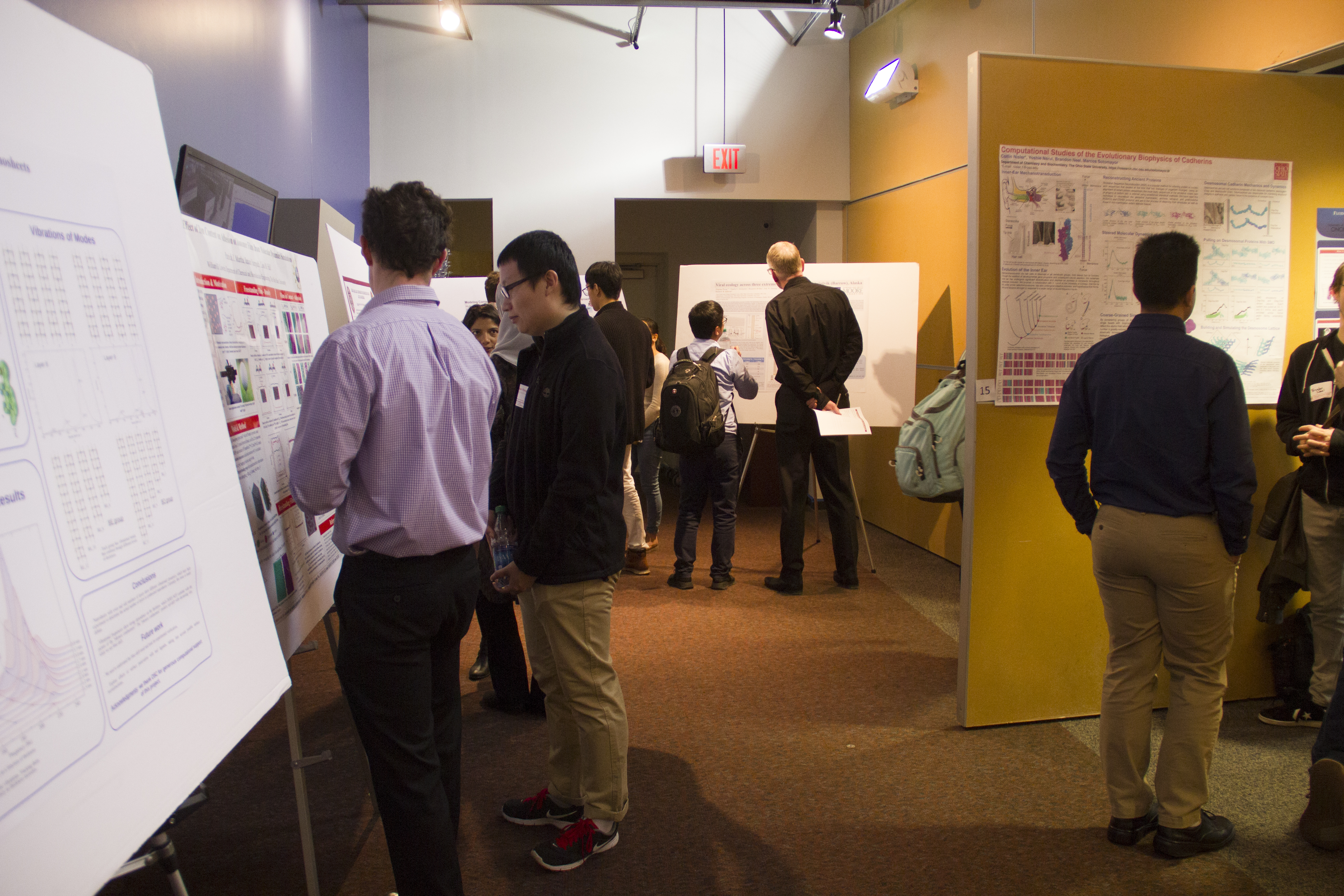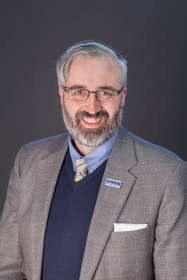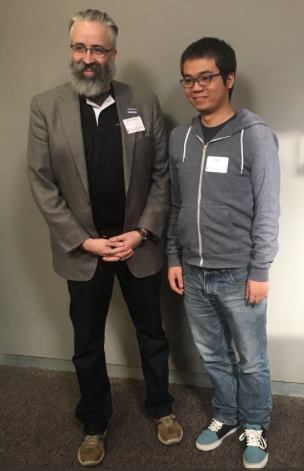
COLUMBUS, Ohio (April 6, 2018) — The demand for high performance computing in Ohio is relentless, and it does not discriminate by field. At Thursday’s Ohio Supercomputer Center Statewide Users Group (SUG) spring conference, OSC clients in fields spanning everything from astrophysics to linguistics gathered to share research highlights and hear updates about the center’s direction and role in supporting science across Ohio.
SUG is a volunteer group composed of the scientists and engineers who provide OSC’s executive director with program and policy advice and direction to ensure a productive environment for research.
Attendees gathered at the Ohio Technology Consortium building for the all-day conference, which included a keynote address from Andrew Siegel, director of application development at Argonne National Laboratory. Breakout sessions provided attendees with deep dives on hardware, software, Big Data, OSC’s OnDemand, and app development, as well as a tour of the State of Ohio Computing Center.
The afternoon offered SUG’s popular poster and flash talk competitions. Participants presented 11 flash talks and 25 posters, competing for a first-place prize of 5,000 resource units of time on OSC systems and a second-place prize of 2,500 resource units. All flash talk and poster competitors received 1,000 resource units.
OSC staff and directors provided updates on the center’s direction as well as a forum for OSC’s client base to give constructive feedback.

“SUG is a great vehicle for us to not only communicate to our clients about what is going on from a policy perspective or hardware roadmaps and new services, but for us to hear back from the clients about what they are doing,” said Brian Guilfoos, HPC client services manager at OSC.“Our normal interaction with someone is very technical – ‘This is the thing I’m trying to do, what I’m having a problem with, etc.’ Here we get to take a broader view and look at the science, and it’s good for our staff to be reminded what is being done with our services and what we are enabling.”
The conference also provided a glimpse into the state of high performance computing at the national level and what it could mean for Ohio’s researchers. In his keynote address, Siegel provided overview and insight into the U.S. Department of Energy’s Exascale Computing Project. Argonne is one of six core national laboratories playing a key role in supporting the nation’s Exascale computing initiative. Exascale computing systems are capable of a thousand-fold capacity increase over current petascale systems.
“We were blessed to have a great keynote speech about the Exascale programs and some of the challenge,” Guilfoos said. “That, I thought, was very interesting and very valuable for our own clients to hear the directions and the ways those Exascale projects may benefit our clients in terms of improving the performance of scientific libraries that we use here. So, if the Exascale project can make improvements to those, we can bring those to our users, they can see better scaling on the systems we work on.”
The flash talks provided researchers with a chance to highlight research around the state that OSC’s systems enable. The Ohio State University’s Lifeng Jin won the flash talk competition for his presentation titled “Unsupervised Depth-bounded Grammar Induction Model for PCFG with Inside-Sampling.” Taking the runner-up position, also from Ohio State, was Jorge Torres with “The Role of HPC in the Radio-detection of Astrophysical Neutrinos.”
The poster competition displayed a wide range of disciplines, including first-place winner Adriaan Riet, from Case Western Reserve University, for his presentation titled “Enhanced Diffusion in an MgO Grain Boundary through Molecular Dynamics Simulations.” There was a tie for the runner-up poster winner. The Ohio State University’s Masood Delfarah’s poster was titled “Recurrent Neural Networks for Cochannel Speech Separation in Reverberant Environments,” and Rosario Distefano, also from Ohio State, shared the distinction with his poster titled “miREpiC: miRNA Editing Profiling in Cancer.”
The next SUG conference will take place in October.

Flash Talk Participants:
- Ginny Cochran, The Ohio State University, Investigating Ultraintense Laser Ion Acceleration Regimes With 3D Particle-In-Cell Simulations
- Xuchun Yang, Bowling Green State University, Role of Vibrational Modes in the Photochemistry of Vision
- Lifeng Jin, The Ohio State University, Unsupervised Depth-bounded Grammar Induction Model for PCFG with Inside-Sampling
- Bishal Bhattarai, Ohio University, Modeling and Simulation of Complex Materials
- Jacob Bowman, The Ohio State University, Impacts of Cardiomyopathy Mutations on Dynamics of Cardiac Troponin C
- Sajjad Afroosheh, Bowling Green State University, Computational Modeling of the Glucose Detection
- Ann Gregory, The Ohio State University,Viral Population Dynamics in Two Freshwater Lakes
- Christopher Arntsen, Youngstown State University, Stochastic GW for Band Gap Calculation in Large Systems
- Jorge Torres, The Ohio State University, The Role of HPC in the Radio-detection of Astrophysical Neutrinos
- Tomas Rojas Solorzano, Ohio University,Strain and Point Defects in MnSe2 Ferromagnetic monolayers
- Zhenlu Li, Case Western Reserve University, A “Tug of War” Maintains a Dynamic Protein Complex at Anionic Membranes
Poster Participants:

- Ben Bolduc, The Ohio State University, Towards Microbiome Informatics at the OSC
- Masood Delfarah, The Ohio State University, Recurrent Neural Networks for Cochannel Speech Separation in Reverberant Environments
- Andrew Eisenhart, University of Cincinnati, The Effect of Ions on the Local Structure of Organic Solvents
- Russell Bonneville, The Ohio State University, Assessment of Tumor Heterogeneity in Metastatic Small Cell Lung Cancer through Rapid Research Autopsy
- Melvin-Eddy Ikwubuo, Miami University, Numerical Simulation of 3-D Printed Surfaces and Resulting Film Cooling Effectiveness
- Rosario Distefano, The Ohio State University, miREpiC: miRNA Editing Profiling in Cancer
- Carrie Doyle, University of Cincinnati, Ion Solvation and Interfacial Potentials: A Multipolar Analysis
- James Kim, The Ohio State University, Incorporating Computational Fluid Dynaics Into the Study of Fractionation of Aged Red Blood Cells
- Chung Hyun Lee, The Ohio State University, Multi-Trace Surface Integral Equation with Hyper-Singular Kernel for Solving Electromagnetic Wave Scattering from Penetrable Tar
- Consuelo Gazitua, The Ohio State University, Virally Mediated Nitrogen Circling in Oxygen Minimum Zones
- Yichao Li, Ohio University, Parallelization of an Optimized DNA Motif Analysis Pipeline with Applications to the Genomes of Multiple Species
- Esther Grossman, Ohio University, Mechanism of Electrochemical Ammonia Synthesis: A Study of Adsorption Energies using Density Functional Theory
- Ho Bin Jang, The Ohio State University, vCONTACT 2.0: Enabling Enhancing Large Scale, Network-Based Automated Prokaryotic Virus Classification
- Puneet Mehra, University of Cincinnati, Fluid-Structure Interaction Simulation for Upper Airway Collapse Due to Obstructive Sleep Apnea
- Collin Nisler, The Ohio State University, Computational Studies of the Evolutionary Biophysics of Cadherins
- Wuwei Lan, The Ohio State University, A Continuously Growing Dataset of Sentential Paraphrases
- ZhiPing Zhong, The Ohio State University, Viral Ecology Across Three Extreme Environments in Barrow, Alaska
- Sirui Li, The Ohio State University, Modeling Corrosion Phenomena with High Performance Computing: A First Principles Approach
- Ola Nosseir, The Ohio State University, Design of a New Class of Compounds for the Resurrection of Aged Acetylcholinesterase
- Patrick Murtha, The Ohio State University, Understanding the Effect of Ion Content on Adhesion of Ionomer Films Using Course Grained Molecular Dynamics Simulations
- Christopher Pyles, Bowling Green State University, Computational Studies of Novel 2D-Materials: PbS Nanosheets
- Alex Russell, The Ohio State University, Simulation of Transient Warm Dense Matter Formed during Ultrashort Laser Pulse Induced Damage using the Particle in Cell Method
- Yun Pu, The Ohio State University, College Admission in Three Chinese Provinces: Boston Mechanism vs. Deferred Acceptance Mechanism
- Adriaan Riet, Case Western Reserve University, Enhanced Diffusion in an MgO Grain Boundary Through Molecular Dynamics Simulations
- Mohammad Sarabian, Ohio University, Computational Modeling of Elastoviscoplastic Suspension Flows